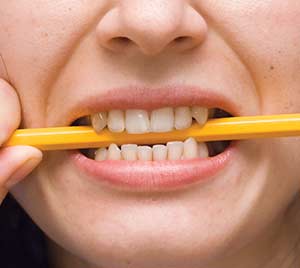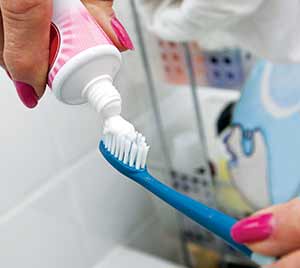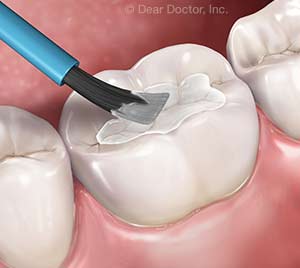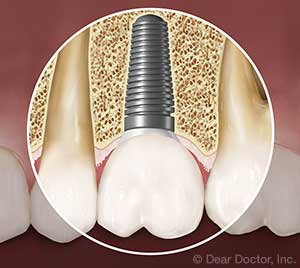Search Results
161 content pages
Periodontal Flap Surgery
When advanced gum disease (periodontitis) develops, your teeth are in danger: At this stage, the ligaments and bone tissue that surround them are being destroyed, and you could even begin losing teeth! If the disease can't be controlled by non-surgical treatments like cleaning and scaling, then periodontal flap surgery may be your best treatment option.
Flap surgery is today's leading method for treating and repairing periodontal pockets. What are these “pockets?” They are areas below the gum line where gum tissue has detached from the teeth, resulting in an uncleansable space where harmful bacteria can proliferate. These bacteria cause inflammation...

Teeth Grinding and Clenching
Teeth grinding and clenching are common habits — but that doesn't mean they are harmless. Stresses from the powerful forces generated by grinding and clenching (also known as “bruxing”) can wear down teeth and even loosen them. When enamel is worn away by this repeated rubbing action, teeth may become sensitive to hot or cold. Dental work such as crowns and fillings may also be damaged. In addition, bruxism can lead to jaw pain and/or headaches.
Even if you have experienced some of these symptoms, you may not realize you are a bruxer — particularly if the behavior occurs at...

Geographic Tongue
Geographic tongue is characterized by harmless lesions, or patches, that can suddenly materialize on the tongue's top surface. The condition gets its name from the physical appearance of the lesions, which resemble smooth, red islands, possibly rimmed with white. Their smoothness comes from the absence of the tiny bumps or “papillae” that normally cover the entire surface of the tongue. These variations in color and texture give the whole tongue a map-like appearance.
The pattern on the tongue can change daily as the lesions appear to move or migrate, healing in one spot only to reappear in another. That's why...

General Dentistry
The practice of general dentistry encompasses an amazing array of services and procedures, all with a common goal: to help you to preserve your natural teeth as long as possible, ensure your oral health, and keep you looking and feeling great throughout life.
Oral health is an essential component of general health. In fact, medical research has revealed links between common oral infections and serious general health conditions including cardiovascular disease. It is therefore of the utmost importance to maintain the health of your teeth, gums, and other oral tissues.
This should start in childhood, so that health-promoting habits can...

Fluoride and Your Teeth
Fluoride is a mineral that is naturally present to some degree in both fresh and salt water sources. Its major dental benefit is that it is readily incorporated into the teeth's mineral structure, thereby making them stronger and more decay-resistant. Fluoride can even reverse tiny cavities that are starting to form. Less tooth decay (professionally defined as “caries”) means you have a better chance of avoiding significant dental treatments — and keeping your natural teeth for life.
The great majority of toothpastes sold today contain fluoride, because it's an effective, easy and inexpensive way to prevent tooth decay and promote...

TMJ Disorders
If you experience ongoing pain in the area near your ear, your jaw or the muscles on the side of your face, possibly accompanied by a clicking or popping sound or restricted jaw movement, you may be suffering from TMD — an abbreviation for Temporomandibular disorders. Sometimes people incorrectly use the term TMJ to refer to these problems, when in fact TMJ is the abbreviation for the temporomandibular joint — or jaw joint — itself. So while you definitely have a TMJ (two of them in fact), you may or may not have TMD.
TMD, then, describes a group of...

Adult Orthodontic Treatment
There are more and more adult orthodontic patients these days, and it's not hard to figure out why. Appliances that are barely noticeable have been developed to give adults more discreet choices when it comes to orthodontic treatment. And many adults realize that investing in a smile makeover can have significant benefits, socially and professionally. Straightening teeth can be an important part of that confidence-boosting makeover process.
Healthy teeth can be moved at any age, so there's no such thing as being too old for braces. However, orthodontic treatment for adults is different in two important respects: For one thing,...

Aging and Dental Health
Today, Americans are not only living longer — we're also retaining our natural teeth longer than ever before. But this rosy picture isn't free of thorns: Older adults tend to require increasingly complex dental treatments; are often more prone to contracting certain diseases; and sometimes find it challenging to keep up with daily oral health practices.
Yet maintaining good oral hygiene is critically important as we age. When problems occur in the mouth, they can cause difficulty chewing, swallowing, speaking and smiling — basic functions which can affect both physical and social well-being. It's possible that medications prescribed for other...

Periodontal Laser Treatment
Since their invention in the early 1960s, lasers have found ever-increasing applications in medicine and dentistry. The latest generation of lasers is now being used in various dental procedures, ranging from disease detection to soft-tissue treatments, and even some hard-tissue procedures like the preparation of small cavities for fillings. One promising area where this technology is having an impact is the field of periodontal (gum) therapy.
Why are more periodontists using lasers? In general, these high-tech tools seem to offer several advantages over conventional treatments for soft-tissue procedures. They are considered minimally invasive treatment methods, meaning that it's possible to...

Diabetes And Oral Health
Diabetes is a group of chronic inflammatory diseases that affect the body's ability to process sugar. If you have diabetes, it is particularly important to maintain excellent oral health. That's because diabetics are more prone to oral infections such as periodontal (gum) disease, which can result in tooth loss if left untreated. Conversely, the presence of gum disease can make it harder for people with diabetes to control their blood sugar levels.
Periodontal disease is a chronic ailment that is also associated with an elevated level of systemic (whole-body) inflammation. Like diabetes, it may have wide-ranging consequences outside the mouth...

Dental X-Rays
X-rays are such a routine part of regular dental care today that it’s hard to imagine what a truly revolutionary impact they have made in dentistry. Discovered by German scientist Wilhelm Röntgen in 1895, x-rays were first utilized by doctors for viewing internal bodily structures in the early 20th Century. By mid-century, dentists were routinely using the technology to diagnose tooth decay and periodontal (gum) disease, as well as other diseases that are not visible through a clinical examination. The ability to see what’s inside the tooth and catch decay or gum disease at early stages has vastly improved the...

Dental Sealants
The most likely location for a cavity to develop in your child's mouth is on the chewing surfaces of the back teeth. Run your tongue over this area in your mouth, and you will feel the reason why: These surfaces are not smooth, as other areas of your teeth are. Instead, they are filled with tiny grooves referred to as “pits and fissures,” which trap bacteria and food particles. The bristles on a toothbrush can't always reach all the way into these dark, moist little crevices. This creates the perfect conditions for tooth decay.
What's more, a child's newly erupted...

Dental Implants
Of all the ways modern dentistry has to replace missing teeth, dental implants are by far the best. There is no tooth-replacement option that will give you a longer-lasting result. Implants also help preserve tooth-supporting bone that naturally deteriorates when a tooth is lost. Loss of bone is one of the major hidden consequences of losing teeth.
A dental implant most often takes the form of a small, screw-shaped titanium post that replaces the root-part of a missing tooth. The surgical procedure used to place an implant is actually quite minor and routine, requiring only local anesthesia in most cases....

Foods to Avoid With Braces
With braces, you're on your way to a beautiful smile. While you are on this exciting journey, please be aware that eating certain types of food can damage the wires or brackets — and make your daily oral hygiene routine more challenging. Not to worry, your orthodontic treatment will all be worth it in the end! But in the meantime you'll want to pay special attention to what you eat. Let's start with the foods you should avoid.
What You Should NOT Eat With Braces:
Popcorn
Popcorn hulls can get stuck under braces, where they are very difficult to remove....

Fixed Dentures
If you have lost an entire arch of teeth (top and/or bottom), or are soon to have your remaining teeth removed because they are too unhealthy to save, you may be able to replace them with fixed dentures supported by dental implants. Doctors and patients alike prefer fixed over removable dentures because they:
Look, feel and function just like natural teeth
Don't slip when you eat or talk
Help prevent bone loss in the jaw
Can last a lifetime
How It Works
Dental implants serve the same purpose as the roots of natural teeth: anchoring the replacement teeth to your...